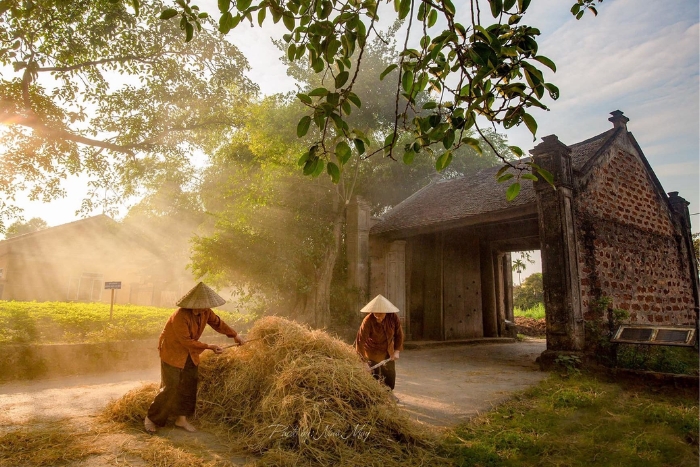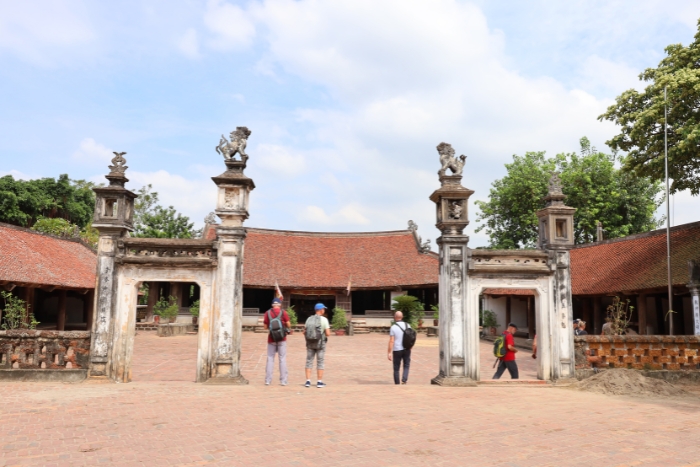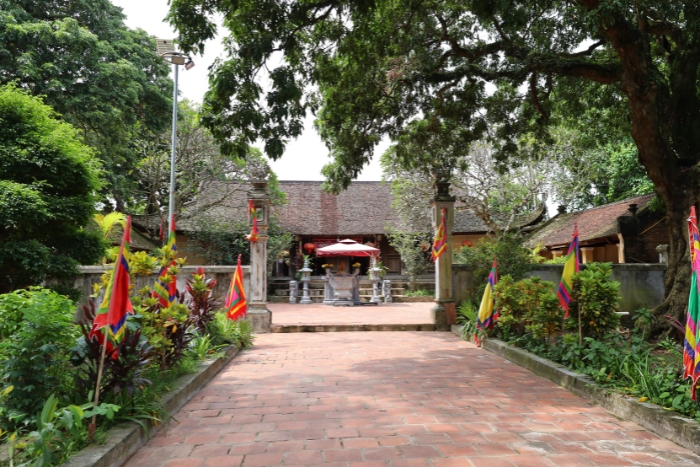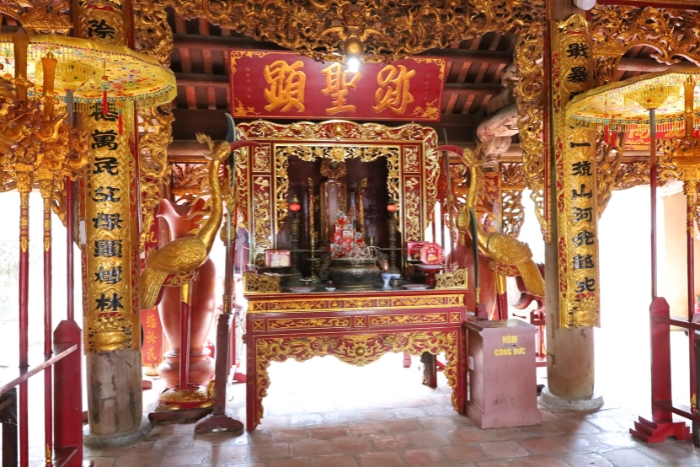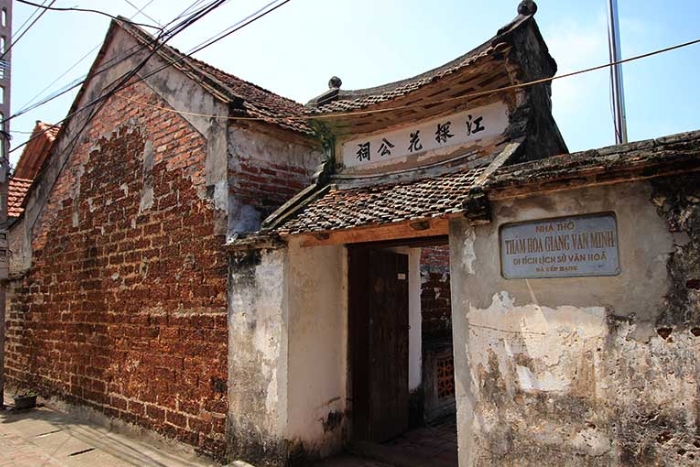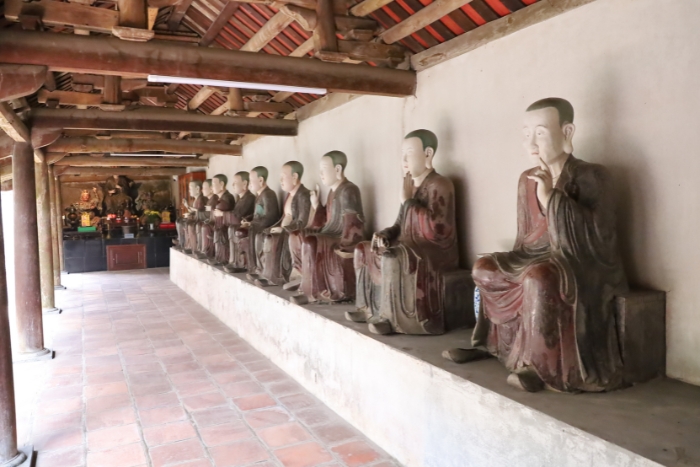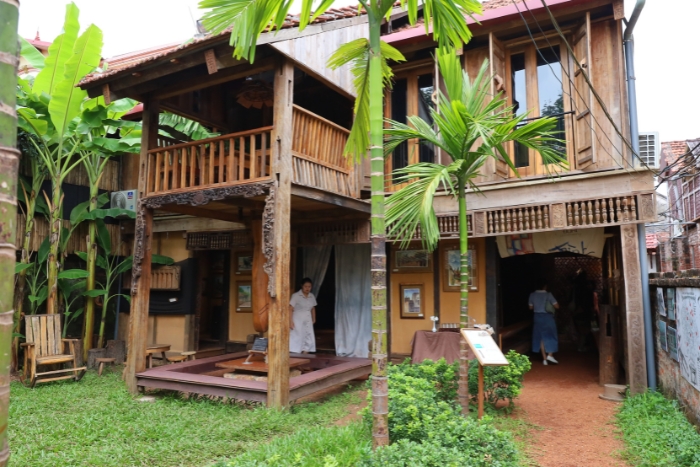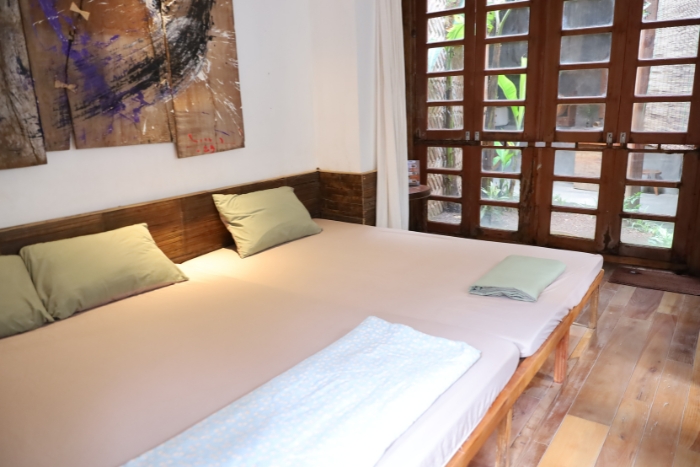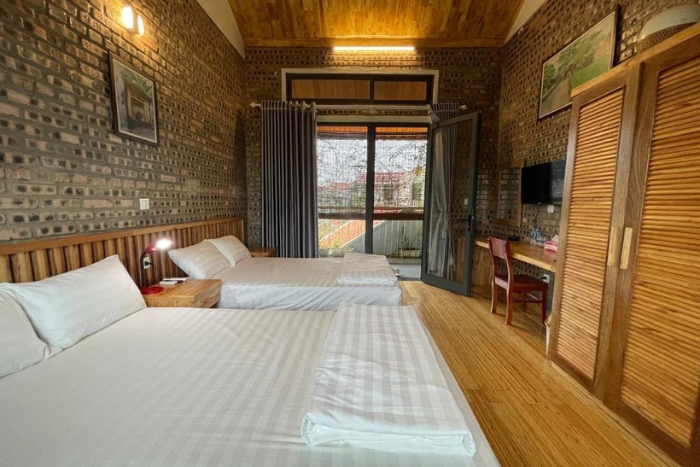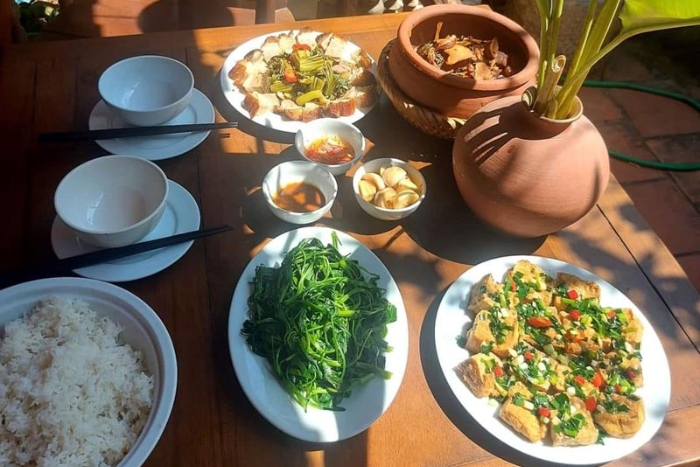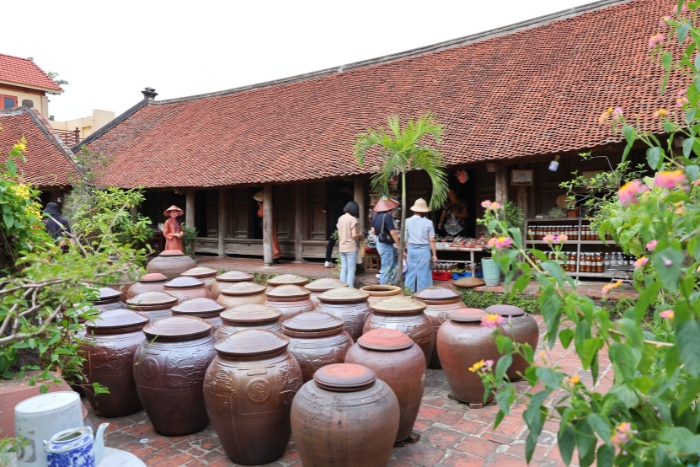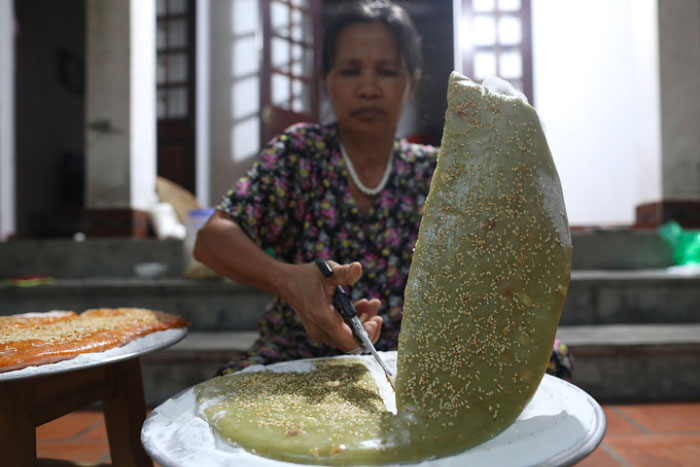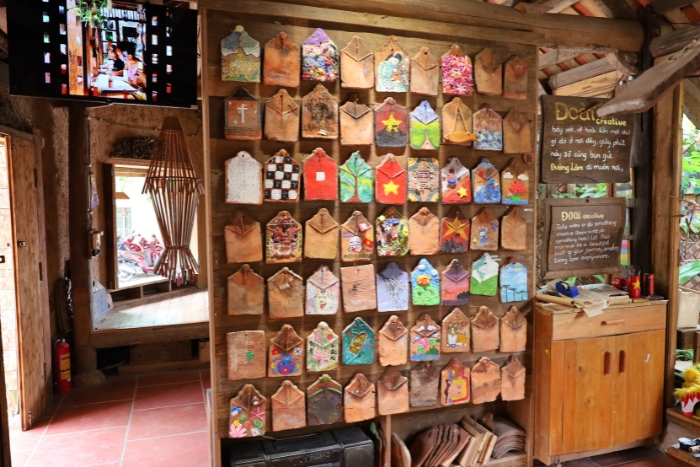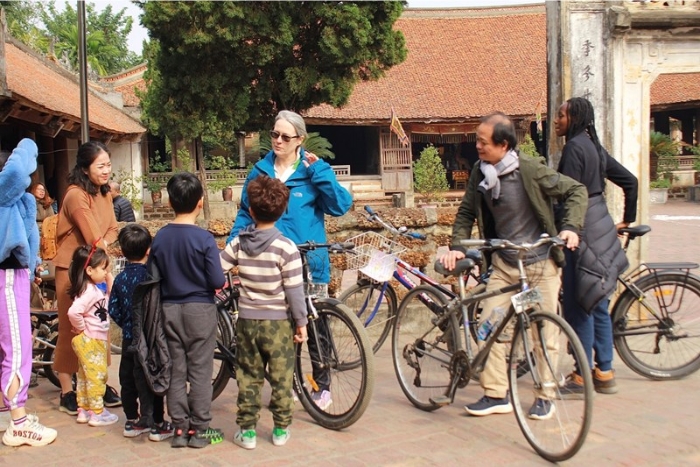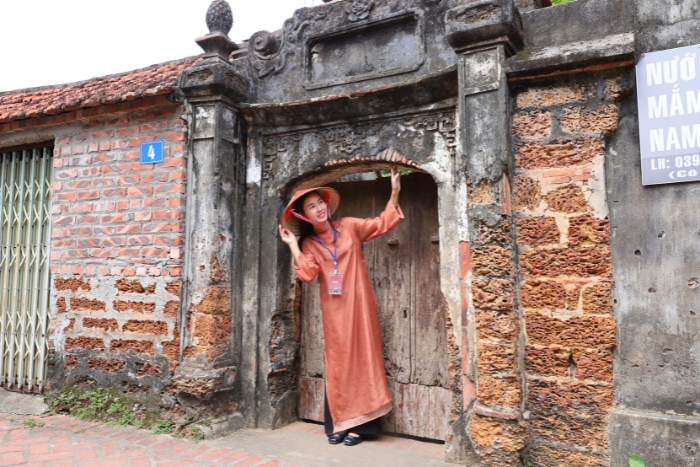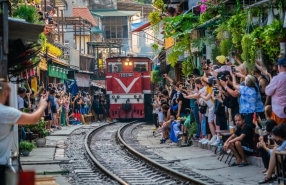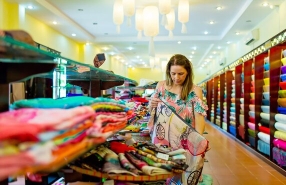
For those considering a trip to Vietnam, take a Duong Lam ancient village tour in Hanoi can be an enriching experience. The village is recognized for its historical charm and traditional architecture, providing a unique glimpse into Vietnam's rural heritage. With its centuries-old houses, winding lanes, and a warm, welcoming community, Duong Lam ancient village offers a peaceful retreat from the busy city atmosphere, allowing visitors to connect with the country's deep cultural roots.
I. Introduction about Duong Lam ancient village
1. Where is Duong Lam ancient village?
Located just 50 kilometers west of Hanoi, Duong Lam ancient village, 300 years old village stands as a charming, historical destination renowned for its traditional architecture and rich cultural heritages. Located right at the intersection of Ho Chi Minh Road and National Road 32, Duong Lam old village offers easy access, making it highly convenient for tourists to visit. It embodies the essence of a typical Northern Vietnamese village, with a history deeply intertwined with the lives of Phung Hung and Ngo Quyen, two prominent figures who shaped the course of Vietnam’s history. This legacy has given Duong Lam its renowned title as the "land of two kings".

Duong lam old village is distinguished by its ancient houses, constructed from laterite stone and wood, offering visitors a glimpse into rural life that has remained largely unchanged over the centuries. As you stroll through its narrow alleys, you’ll encounter traditional homes, ancient wells, communal houses, and temples that reflect the enduring spirit of Vietnamese architecture. The landscape is further enriched by centuries-old banyan trees and sprawling rice fields, enhancing the village's tranquil, picturesque atmosphere.
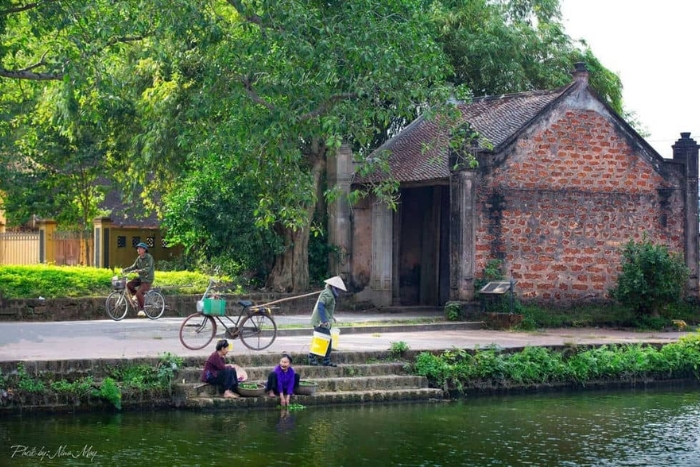
Beyond its architectural charm, Duong Lam village Hanoi is a living museum of Vietnamese culture and traditions. Local residents continue to practice time-honored activities such as crafting soy sauce and making traditional rice cakes, providing visitors with an authentic taste of village life. Recognized as the first national heritage site, Duong Lam stands as a symbol of the beauty and resilience of Vietnam’s rural heritage, preserving its essence amidst the challenges of modernization.
2. How to get there ?
Duong Lam Ancient Village is about 44 kilometers from central Hanoi, and you can get there by:
- By Motorbike: Traveling by motorbike allows flexibility to explore at your own pace. There are two main routes:
- Take Thang Long Boulevard, turn right at Hoa Lac Junction, and follow National Road 21. At the intersection with National Road 32, follow the signs to Duong Lam.
- Alternatively, take National Road 32 to Son Tay Town, then turn left at the intersection with National Road 21 to reach the village.
- By bus : Buses 20A, 70, 71, and 77 all stop near Duong Lam. Get off at Son Tay bus station and take a short motorbike taxi or taxi ride to the village.
- By car: For a comfortable and private trip to Duong Lam Ancient Village, choosing a car is an excellent option. Contact AUTOUR ASIA - your trusted Vietnam travel agency for the best deals and a hassle-free experience.
No matter which way you choose, these options offer easy access to this historic destination.
Note : Entrance ticket 20.000VND (1 euro) per person. You can buy it at the old gate of Mong Phu with the ticket booth. There is also another one at the new gate of Duong Lam ancient village. But I do recommend to get it in the old gate for your convenience.
3. What is the best time to visit?
Duong Lam Ancient Village Hanoi is a beautiful destination year-round, but the festive and harvest seasons offer the most memorable experiences.
- In the festive season (first lunar month)
Visiting during the first lunar month lets you soak in the lively festival atmosphere. The village’s communal house becomes the center of celebrations with colorful palanquins, traditional offerings, and folk games. The sound of cheering drums and vibrant festivities, along with special festival-only dishes, create an unforgettable cultural experience.
- In the harvest season (May–June)
In May and June, as the rice fields ripen, Duong Lam Hanoi transforms into a peaceful, rural haven. The roads are lined with golden rice and straw, offering a tranquil, picturesque scene that beautifully complements the village's ancient charm. Whether for the vibrant festivals or serene harvest, Duong Lam promises a captivating journey into Vietnam’s cultural heritage.
II. What to visit in Duong Lam ancient village?
1. Mong Phu Gate & Mong Phu communal house
Mong Phu Gate, built during the reign of King Le Thanh Tong, is considered the most iconic architectural feature of Duong Lam village. The gate showcases a traditional arched design made from laterite stone, reflecting layers of cultural history. Originally, the village had five gates—one main gate and four smaller ones guarding the cardinal directions. Today, only Mong Phu Gate remains, reconstructed in 1833, with the inscription "Thế hữu hưng ngơi đại", meaning "Every era produces talented people." This place is also a fantastic spot for tourists to capture stunning photos when visiting this Hanoi ancient village.
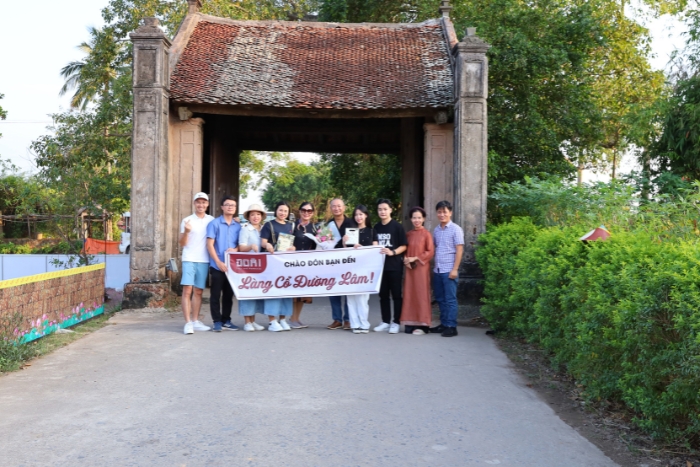
Mong Phu Communal House is a quintessential example of Northern Vietnam's countryside architecture, built nearly 380 years ago in the heart of the village. Spanning approximately 1,800 square meters, the structure features distinct ethnic architectural elements, resembling a stilt house with wooden floors elevated above the ground. Inside, visitors can find numerous ancient parallel sentences that have hung there for centuries, showcasing the rich cultural heritage of the region. This communal house is regarded as a hallmark of Vietnamese architectural excellence, drawing numerous tourists eager to admire its beauty and historical significance
2. Temple of Phung Hung
Phung Hung, a national hero who led a successful uprising against the Tang Dynasty’s oppressive rule in the 8th century, established an autonomous government and ruled for seven years. To honor his legacy, many temples were built across Vietnam, but the Phung Hung Temple in Duong Lam Ancient Village, his birthplace, is the largest and most sacred. This temple, restored in 1889 with distinct Nguyen Dynasty architectural features, houses a stele detailing his life and achievements. Every year, on the 8th day of the first lunar month, locals and tourists gather at the temple to pay tribute to this revered leader.
3. Mausoleum and temple of Ngo Quyen
The Mausoleum and Temple of Ngo Quyen in Duong Lam ancient village Hanoi honor Ngo Quyen , a national hero and the first king of an independent Vietnam after defeating the Southern Han at the historic Battle of Bach Dang in 938. Located on Cam Hill, about 2.2 kilometers east of Mong Phu Communal House and 500 meters from the Phung Hung Temple, the site consists of a temple built on higher ground and a mausoleum situated 100 meters to the south. As Ngo Quyen’s birthplace, Duong Lam holds deep historical significance, and the complex serves as a place of reverence where locals and visitors pay homage to his legacy, celebrating Vietnam’s independence and sovereignty.
4. Giang Van Minh worship house
The Giang Van Minh Worship House is a historical relic constructed during the reign of King Tu Duc to honor the contributions of Giang Van Minh, who was sent by King Le Thanh Tong to China to defend the nation's honor in response to the Minh court. Today, the worship house serves as a popular tourist destination for those interested in Vietnamese history and culture, while also acting as a vital place for instilling patriotic traditions in future generations.
5. Mia Pagoda
Mia Pagoda (Sung Nghiem Tu), located in the heart of Duong Lam Ancient Village, is not only a historic pagoda but also home to the largest collection of artistic statues in Vietnam, featuring 287 unique pieces. These include 107 statues made from rice husks and molasses, 174 carved from wood, and 6 cast in bronze, reflecting exceptional craftsmanship and artistic diversity.
With its distinctive architecture, tranquil atmosphere, and serene surroundings, Mia Pagoda serves as both a sacred site for prayer and a cultural treasure, offering visitors a profound insight into the Buddhist heritage and spiritual traditions of Duong Lam old village.

Sophia recounted her unforgettable one-day journey to Duong Lam Village.
Visiting Duong Lam Village in Hanoi felt like stepping into a living museum where history comes alive. I was captivated by the intricate architecture of the centuries-old laterite houses, each telling stories of the past with their unique textures and designs. Strolling through the narrow, winding alleys filled with a sense of timelessness, I marveled at the peaceful ambiance, enhanced by the gentle chatter of friendly locals and the scent of traditional dishes being prepared.
Experiencing their warm hospitality and learning about ancient customs, I savored every bite of dishes like che lam and banh te, which added layers of flavor to my visit. This blend of history, culture, and community made my trip truly unforgettable.
III. Where to stay in Duong Lam ancient village?
1. Doai’s Homestay
Nestled in the heart of Duong Lam ancient village, Doai Homestay offers a truly authentic experience of Northern Vietnam’s traditional architecture. With four charming, rustic rooms spread across two floors, each comfortably accommodating up to four guests, this homestay invites you to step back in time while enjoying modern comforts. Surrounded by lush greenery and the serene countryside, Doai Homestay combines the simplicity of rural life with the relaxation of peaceful garden spaces.
Visitors can immerse themselves in village life, savor local cuisine, and unwind in an environment that perfectly blends tradition and tranquility. More than just a place to stay, Doai Homestay provides a rich cultural experience, allowing you to learn about the local heritage while enjoying the quiet, natural surroundings.
For those seeking peace and a connection to traditional values in the midst of modern life, Doai Homestay is the ideal retreat. Come and experience the essence of Northern Vietnam’s countryside and culture.
2. Doai Tour and homestay
For a warm and inviting stay in Duong Lam old village, Doai Tour and Homestay is the perfect choice. It features four boutique rooms, each named after the village’s traditional hamlets: Xóm Đình, Xóm Hè, Xóm Sui, and Xóm Sải. Combining rustic charm with modern luxury, each room is thoughtfully designed with private bathrooms and refined amenities, offering a blend of comfort and elegance.
Surrounded by the peaceful beauty of the countryside, Doai Tour and Homestay immerses guests in the rich cultural heritage of the village, providing an authentic experience that feels both familiar and serene. Whether you’re looking to relax or connect with local traditions, this homestay is the ideal retreat to enjoy the simplicity, charm, and timeless beauty of Duong Lam.
Let Doai Tour and Homestay be your sanctuary, where you can experience the essence of Duong Lam’s beauty and embrace the simplicity and warmth of every moment.
3. Duong Lam homestay - House number 09
Duong Lam Homestay – House No. 09 is one of the top accommodation options for visitors looking to experience the charm and history of Duong Lam Ancient Village. Nestled in the heart of this cultural treasure, House No. 09 offers a unique blend of traditional Northern Vietnamese architecture and modern comfort. The homestay features beautifully restored, rustic interiors with all the amenities needed for a comfortable stay, providing guests with an authentic and cozy atmosphere.
With its prime location, guests can easily explore the village’s ancient streets, temples, and traditional houses. Whether you're seeking relaxation or cultural immersion, Duong Lam Homestay – House No. 09 is the perfect retreat for tourists looking to truly connect with the history and heritage of Duong Lam.
IV. Where to eat in Duong Lam? Top specialties of Duong Lam ancient village
If you're exploring Duong Lam and wondering where to eat, don't miss these recommended spots. We're confident you'll enjoy these trusted suggestions for a satisfying meal!
Bep Lang Duong Lam is one of the top-rated spots for tourists to enjoy authentic local cuisine in Duong Lam Ancient Village. Known for its traditional ambiance and rustic setting, this charming restaurant offers a variety of local dishes made from fresh, locally-sourced ingredients, perfect for a lunch or dinner experience. Popular menu items include bánh tẻ (rice cakes), măng hầm giò (bamboo shoots with pork), and chè lam (sweet rice cake). With its warm hospitality and authentic flavors, Bếp Làng Duong Lam is a must-visit for anyone looking to savor the taste of local culture.
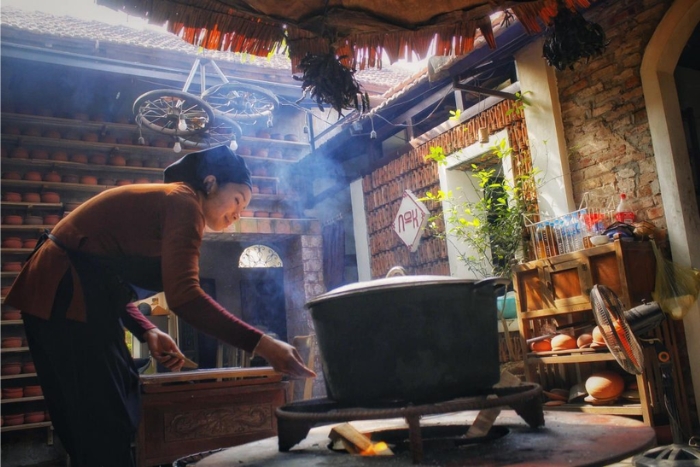
Ancient House of Mr. The is not only a long-standing architectural masterpiece but also a valuable cultural heritage site. This beautifully preserved home reflects traditional Vietnamese architecture, featuring wooden columns, tiled roofs, and ancient courtyards that transport visitors to the past, a perfect place for toursits taste Vietnamese traditional cuisine, specially enjoy Vietnamese ban soy sauce ( tương bần)
More than just a dining venue, the house preserves the essence and flavors of Northern Vietnamese cuisine. Guests can enjoy authentic dishes prepared with locally sourced ingredients, including the village’s renowned ban soy sauce. Whether for a shaded lunch or an intimate dinner, dining here is an immersive experience in both history and culinary tradition. The Ancient House of Mr. The is a must-visit destination for those seeking to savor the rich culture and cuisine of northern Vietnam.
And you can also have lunch at some other homestays in the ancient village. But note that, remember to contact to book a table in advance.
1. Chè Lam (sticky rice ginger peanut bars)
A trip to Đường Lâm Ancient Village wouldn’t be complete without savoring the iconic chè lam, a sweet delicacy that has captured the hearts of locals for generations. Crafted from simple yet flavorful ingredients like sticky rice, molasses, fresh ginger, and roasted peanuts, chè lam delivers a rich, satisfying taste that lingers long after your first bite.
With its chewy texture and the warming hint of ginger, each piece of chè lam is more than just a treat; it's a symbol of Đường Lâm’s hospitality and timeless cultural heritage. What could be better than enjoying che lam with
Vietnamese tea, a perfect combination for a refreshing experience. This traditional snack reflects the warmth and history of the village, offering visitors a genuine taste of its soul. Don’t miss the chance to experience the essence of Vietnamese tradition. Visit
Duong Lam ancient village, indulge in chè lam, and let this delicious treasure leave a lasting impression on your journey!
2. Gà Mía (Mia chicken)
When you take a Duong Lam ancient village tour, one dish that should not be missed is the famous Mía chicken. Known for its succulent texture and rich flavor, Mía chicken is a prized local delicacy. Raised in the natural countryside and fed a diet that includes sugarcane, these chickens boast tender, slightly sweet meat with a golden, crispy skin that sets them apart.
This flavorful dish is traditionally prepared in various ways such as boiled, grilled, or stewed, each method highlighting the unique qualities of the chicken. Mía chicken is more than just a meal; it's a celebration of the village's rich culinary heritage and a must-try for anyone looking to savor the authentic taste of Northern Vietnam.
3. Tương bần (Ban Soy Sauce)
A standout specialty of Duong Lam old village its traditional Ban soy sauce (tương bần), a cherished condiment passed down through generations. Crafted from soybeans, sticky rice, salt, and water, this sauce undergoes a careful fermentation process that spans several months, developing its deep, umami-rich flavor. Known locally as Ban Soy Sauce, it’s commonly used as a dipping sauce for boiled vegetables, tofu, or meat, and serves as a flavorful marinade in many Vietnamese dishes.
More than just a sauce, Ban Soy Sauce represents the village’s dedication to preserving its culinary heritage. Visitors to Duong Lam can savor an authentic taste of Northern Vietnam’s rustic cuisine, steeped in tradition and local pride.
In addition to these specialities, Duong Lam Ancient Village offers a variety of other mouthwatering specialties that will enhance your culinary journey. Treat yourself to dishes like roasted pork, peanut candy, stuffed candy, and the local favorite, bánh tẻ (a type of rice cake). Each of these traditional delicacies reflects the rich flavors and heritage of the village, making your exploration of Vietnamese cuisine even more delightful and unforgettable.
V. Enhance your Duong Lam ancient village trip with memorable activities
1. Shadow puppet show at Đoài
Have you ever here or wondered what inspired the shadow puppet show at Đoài? It’s a kind of Vietnamese traditional art. It all began on tranquil summer nights, when power outages would drape the village in darkness. Children would gather by candlelight, their hands and everyday objects crafting playful shadows on the walls. Their laughter echoed through the night, and their limitless imagination transformed the darkness into a stage for magical tales.
At Đoài, those nostalgic memories come alive with simple yet elegant puppets, bringing you back to a time when the night was not feared but embraced as a canvas for endless creativity. Join us this weekend at Đoài and relive the magic.
The show runs from 8:30 PM to 9:30 PM every Friday and Saturday
2. Join with Doai’s creative
Join Doai Homestay’s creative and engaging activities to fully experience the charm of Duong Lam ancient village Hanoi. Visitors can participate in hands-on activities such as traditional cooking classes featuring local specialties like Ban Soy Sauce (Tương bần) and authentic Vietnamese dishes.
Unleash your creativity and experience with the roof tile painting activity, explore the village on a bicycle tour, visiting ancient houses, temples, and rice fields, or join craft workshops to learn traditional skills like making rice paper and weaving.
Doai also offers cultural exchanges with locals, giving guests a deeper understanding of village life and customs. These activities make Doai not just a place to stay but a vibrant gateway to discover the rich heritage and traditions of Northern Vietnam.
3. Bicycle tour in Duong Lam ancient village
Discover the enchanting Duong Lam Ancient Village tour by bicycle, where you can explore historic hamlets, admire trade hamlets and ancient houses. Rent bikes easily at the village entrance or local guest houses for approximately from 2 - 3 USD per day, including helmets and locks. Choose a half-day ride to see the main attractions or a full-day adventure through picturesque rice fields, local markets, and scenic countryside. Engage with friendly villagers, savor authentic Vietnamese cuisine, and shop for handmade souvenirs. Remember to bring comfortable clothing, sun protection, water, and a camera.
Whether you’re passionate about history or nature, cycling in Duong Lam Hanoi offers a peaceful and immersive way to experience Vietnam’s rich cultural heritage and beautiful rural landscapes.
4. Celebration Tết with local
Celebrate Tet in Duong Lam Ancient Village, the perfect place for foreign visitors eager to experience authentic Vietnamese Lunar New Year traditions with the program "Vietnamese Têt"(Tết Làng Việt). Participate in a variety of activities, including tours of lively traditional Tet markets to witness vibrant local commerce, and enjoy captivating ethnic art performances at the Mong Phu communal house yard. Explore the village’s unique spots and visit booths showcasing local specialties, handcrafted products, and craft villages. Engage in traditional Tet customs with hands-on activities such as calligraphy, shaping To He (toy figurines), and playing folk games like cockfighting, catching loach in a jar, and blindfolded pot smashing.
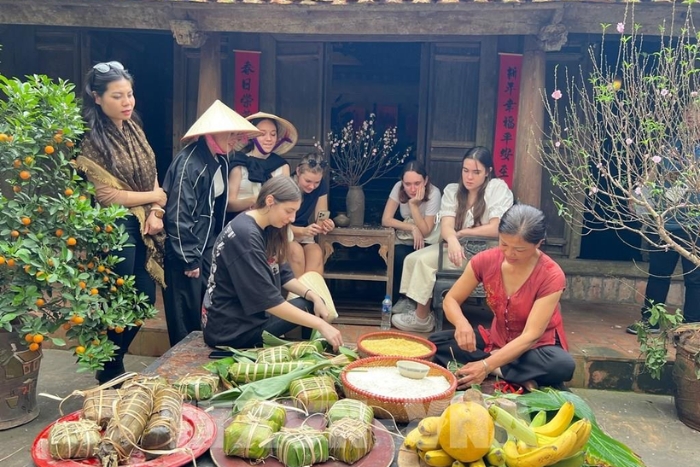
For a better experience, you can learn about essential Tet traditions, including the New Year's Eve ceremony, carp fish release, and the giving of Li Xi (lucky money), while savoring Duong Lam’s famous Tet cuisine, featuring dishes like banh chung, Mia chicken, and roasted pork. Enhance your visit by staying in a local homestay, renting a bicycle to navigate picturesque rice fields and historic sites, and trying your hand at wrapping banh chung and gio. Best experienced between late January and early February, Duong Lam Hanoi offers a memorable Tet celebration that beautifully blends rich cultural heritage, traditional customs, and warm community spirit, making it a must-visit destination during Vietnam’s most cherished holiday.
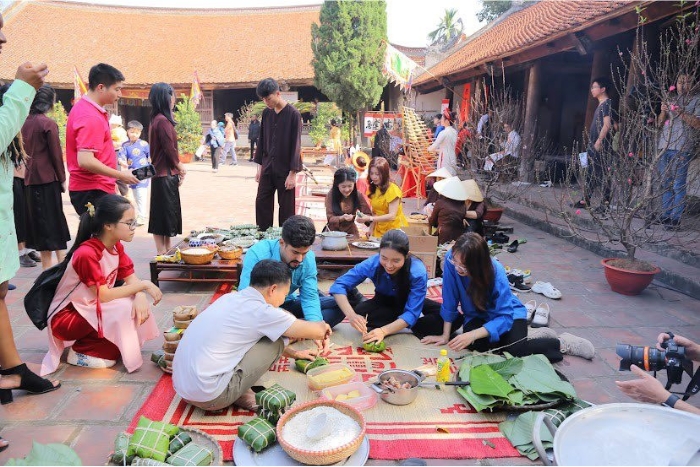
Alexander shared his experience of joining the Tết celebration with the locals in Duong Lam Village:
"I had an incredible experience celebrating Tết with the locals in Duong Lam Village. The lively atmosphere, with traditional festivities and vibrant decorations, drew me in instantly, and the warm hospitality of the villagers made me feel right at home. Participating in age-old customs, tasting delicious festive dishes, and enjoying cultural performances made the day unforgettable. The community’s deep-rooted traditions and joyful spirit left a lasting impression on me, making it a celebration I’ll cherish forever."
VI. Some useful tips for your memorable trip to Duong Lam ancient village
Enjoy your trip to Duong Lam ancient village Hanoi with the following remarkable tips from us:
- Respect Local Culture: Duong Lam ancient village is still home to local families. Be respectful by asking for permission before entering private homes and observing local customs, especially in temples and communal houses.
- Keep noise levels low, especially around temples and communal houses, out of respect for the locals and the tranquil environment.
- Knowing a few greetings or phrases like “Xin chào” (Hello) and “Cảm ơn” (Thank you) will make interactions with locals more enjoyable and appreciated.
- Eco- friend travel : Be mindful of the environment. Dispose of trash properly and bring a reusable water bottle to reduce plastic waste.
- Many parts of the village are open, with limited shade. Wearing a hat and sunglasses will help you stay comfortable, especially on sunny days.
- Besides, you can purchase handcrafted products directly from artisans to support the local community. Popular souvenirs include soy sauce, rice wine, bamboo crafts, and straw hats.
We hope that with these extra tips, your journey to Duong Lam old village will be smooth and enriching, allowing you to fully immerse yourself in its rich history, vibrant culture, and serene beauty.
Traveling to Vietnam offers a unique opportunity to immerse yourself in the country's rich cultural tapestry, and Duong Lam Ancient Village in Hanoi is a perfect place to start. This charming village, with its ancient architecture and deep historical significance, provides an authentic glimpse into rural Vietnamese life. Walking through its peaceful lanes, admiring traditional houses, and interacting with the friendly locals, you'll experience a side of Vietnam that is both timeless and captivating. A journey to Duong Lam ancient village Hanoi is more than just a visit; it's a step into the living history of Vietnam, where every corner tells a story of resilience, tradition, and beauty.
Is Duong Lam ancient village safe for travelling with kids?
Yes, Duong Lam Village is generally safe for traveling with kids, offering a peaceful environment with well-preserved traditional architecture. However, parents should be cautious when cycling around the village, ensuring proper safety measures like secure child seats, and keeping an eye on kids near open wells and historical structures.
Should I get a guide for Duong Lam village?
It's highly recommended to hire a guide when visiting Duong Lam Ancient Village. A guide can provide in-depth insights into the village's rich history, architecture, and cultural landmarks, such as Mong Phu Temple and Mia Pagoda. They can also help you navigate the narrow alleys and facilitate interactions with locals, offering a more immersive and meaningful experience of traditional Vietnamese village life.



